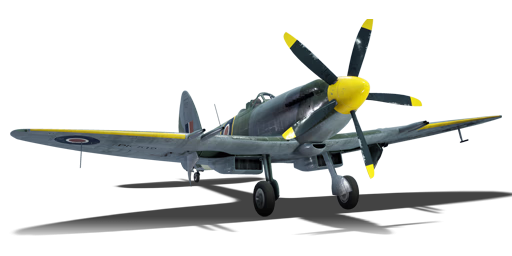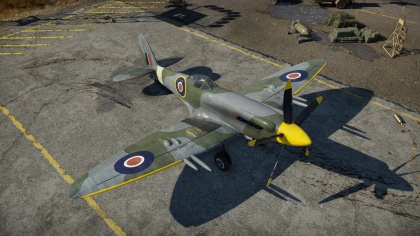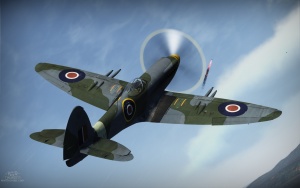Difference between revisions of "Spitfire F Mk 22"
(commented out section description) |
(→Flight performance: Updated) |
||
| Line 30: | Line 30: | ||
|- | |- | ||
! Upgraded | ! Upgraded | ||
| − | | | + | | 788 || 740 || 17.3 || 18.2 || 31.5 || 23.7 |
|- | |- | ||
|} | |} | ||
Revision as of 16:47, 29 September 2020
Contents
| This page is about the British fighter Spitfire F Mk 22. For other versions, see Spitfire (Family). |
Description
The Spitfire F Mk 22 is a rank IV British fighter
with a battle rating of 5.7 (AB), 6.7 (RB), and 6.0 (SB). It was introduced in Update 1.39.
General info
Flight performance
| Characteristics | Max Speed (km/h at 8,232 m) |
Max altitude (metres) |
Turn time (seconds) |
Rate of climb (metres/second) |
Take-off run (metres) | |||
|---|---|---|---|---|---|---|---|---|
| AB | RB | AB | RB | AB | RB | |||
| Stock | 706 | 685 | 11800 | 19.4 | 20.2 | 18.5 | 18.5 | 420 |
| Upgraded | 788 | 740 | 17.3 | 18.2 | 31.5 | 23.7 | ||
Details
| Features | ||||
|---|---|---|---|---|
| Combat flaps | Take-off flaps | Landing flaps | Air brakes | Arrestor gear |
| X | X | ✓ | X | X |
| Limits | ||||||
|---|---|---|---|---|---|---|
| Wings (km/h) | Gear (km/h) | Flaps (km/h) | Max Static G | |||
| Combat | Take-off | Landing | + | - | ||
| 875 | 260 | N/A | N/A | 260 | ~11 | ~6 |
| Optimal velocities (km/h) | |||
|---|---|---|---|
| Ailerons | Rudder | Elevators | Radiator |
| < 482 | < 400 | < 400 | > 500 |
| Compressor (RB/SB) | ||
|---|---|---|
| Setting 1 | ||
| Optimal altitude | 100% Engine power | WEP Engine power |
| 4,600 m | 1,510 hp | 2,190 hp |
| Setting 2 | ||
| Optimal altitude | 100% Engine power | WEP Engine power |
| 8,600 m | 1,360 hp | 1,933? hp |
Survivability and armour
- 42.8 mm Bulletproof glass - Armoured windscreen
- 4 mm Steel - Armoured pilot seat
- 4 mm Steel - Armour plate behind the pilot seat
- 7 mm Steel - Armour plate behind the pilot seat
- 3 mm Steel - Armoured boxes around the wing ammunition (each wing)
- 12.7 mm Steel - Armoured plate between fuel tanks.
- 6 mm Steel - Armoured plate in front of the liquid cooling system.
Armaments
Offensive armament
The Spitfire F Mk 22 is armed with:
- 4 x 20 mm Hispano Mk.II cannons, wing-mounted (150 rpg outer + 175 rpg inner = 650 total)
Suspended armament
The Spitfire F Mk 22 can be outfitted with the following ordnance:
- Without load
- 2 x 250 lb G.P. Mk.IV bombs (500 lb total)
- 3 x 250 lb G.P. Mk.IV bombs (750 lb total)
- 2 x 500 lb G.P. Mk.IV bombs (1,000 lb total)
- 1 x 500 lb G.P. Mk.IV bomb + 2 x 250 lb G.P. Mk.IV bombs (1,000 lb total)
- 3 x 500 lb G.P. Mk.IV bombs (1,500 lb total)
- 6 x RP-3 rockets
Usage in battles
The Spitfire F Mk 22 an excellent plane in Realistic battles with relatively few weaknesses, so the enemy will have a really hard time shaking the Spitfire off of its tail and only few will succeed.
It is very important to avoid hard turning or rolling above 500 km/h IAS, because the plane may lose its wing.
The main task for a pilot is to utilize the great climb rate (altitude allows you to control engagements). Target altitude should usually be around 5-6 km on smaller maps and 6-7 km on larger maps such as Norway and Spain. The main form of attack (especially when there are more fighters around the target) is Boom & Zoom. Energy fighting is an option too, if in a 1 vs 1 situation. The Griffon Spitfire is an excellent energy fighter, the namesake Griffon engine provides a tremendous amount of horsepower which can be used instead of energy retention (-> Boom & Zoom). Remember to maintain speed, altitude advantage, and judge the enemies' energy states.
Specific enemies worth noting
Griffon Spitfire can keep up with most enemies in turn fights, excluding most Japanese fighters and Bf 109s, both of which are more agile. Try to maintain a speed of between 400-500 km/h IAS; this is where the plane maintains great agility, turning below this velocity against planes such as the Bf 109 G-14 is really not recommended. When fighting Soviet fighters it is NOT recommended to duel them between 1-4 km altitude.
Manual Engine Control
| MEC elements | ||||||
|---|---|---|---|---|---|---|
| Mixer | Pitch | Radiator | Supercharger | Turbocharger | ||
| Oil | Water | Type | ||||
| Not controllable | Controllable Auto control available |
Not controllable Not auto controlled |
Controllable Auto control available |
Combined | Controllable 2 gears |
Not controllable |
Modules
| Tier | Flight performance | Survivability | Weaponry | ||
|---|---|---|---|---|---|
| I | Fuselage repair | Radiator | HSBC mk.2 | HSBC mk.3 | |
| II | Compressor | Airframe | HMBC mk.2 | HMBC mk.3 | |
| III | Wings repair | Engine | Offensive 20 mm | HRC mk.8 | |
| IV | Engine injection | Cover | Mk.II year 1943 | ||
- The Griffon is Energy fighter/Boom & Zoom plane (suggested upgrade order):
- Fuselage Repair
- Radiator
- Compressor
- Airframe
- Offensive 20 mm
- Engine
- Wings Repair
- Fuel Injection
- Cover (many of the upgrades are crucial to boosting the aircraft's speed and climb rate)
Pros and cons
Pros:
- 4 x cannons with a high rate of fire
- Excellent climb rate
- Quite agile at medium and higher speeds
- Very responsive elevator(starts to lock at speeds above 600 km/h IAS)
- Greatly improved high-speed handling relative to previous spitfires
- Wing rip speed is noticeably higher than previous spitfires
- Brutal acceleration when using WEP
- Good performance at higher altitudes
- Excellent roll rate
Cons:
- From time to time, pitted against jets which can be tricky to outmanoeuvre
- Poor agility at lower speeds and significant drag/mass ratio at high speeds limits optimal combat speed range
- Easily set on fire due to the location of the fuel tanks
- Landing gear rips very easily during take-off and landing travelling in excess of 260 km/h
- Landing flaps also break off at roughly the same speed as the gear
- Somewhat sluggish without utilizing WEP
History
In-game description
The Supermarine Spitfire Mk.22 was a single engine, single seat fighter which served with the Royal Air Force during the early post war period. When the first Rolls Royce Griffon equipped Spitfires were tested it was obvious that a stronger airframe would be needed to harness the full power of the new engine. Added to this was the requirement for a much stiffer wing; the result of these findings was the Spitfire Mk.21. The Mk.21 was also fitted with larger ailerons and the same 2050 hp Griffon 65 engine which was fitted to the Mk.XIV and Mk.XVIII. By this point in the aircraft's life, the Spitfire was so different from RJ Mitchell's original concept that the notion of renaming the new aircraft the 'Victor' was considered.
The Air Fighting Development Unit at RAF Boscombe Down began to test the Mk.21 in late 1944, but were deeply unhappy with the new Spitfire and recommended that no further attempts were made to progress the basic Spitfire design. Chief amongst the AFDU's complaints was directional instability: Supermarine attempted to solve this problem by modifying the control surfaces. It was only with the introduction of a new, enlarged tailfin and tail plane which finally solved the instability problems.
The Mk.22 differed from the Mk.21 only in having a teardrop bubble canopy – a change which had not required a new mark number in previous Spitfires – and a different electrical system. The Mk.22, as with the Mk.21, was armed with four 20mm Hispano cannons. The Mk.22 was more prolific and more successful than the Mk.21, with some 280 aircraft being manufactured. It was used to equip No.73 Squadron and twelve squadrons of the Royal Auxiliary Air Force. In 1955 the Spitfire Mk.22 was declared obsolete by the RAF and many were exported to South Rhodesia, Syria and Egypt.
Media
See also
Links to the articles on the War Thunder Wiki that you think will be useful for the reader, for example:
- reference to the series of the aircraft;
- links to approximate analogues of other nations and research trees.
External links
Paste links to sources and external resources, such as:
- topic on the official game forum;
- encyclopedia page on the aircraft;
- other literature.
| Supermarine | |
|---|---|
| Spitfires | |
| Merlin engine | Spitfire Mk Ia · Spitfire Mk IIa · Spitfire Mk.IIa Venture I · Spitfire Mk IIb |
| Spitfire Mk Vb · Spitfire Mk Vb/trop · Spitfire Mk Vc · Spitfire Mk Vc/trop | |
| Spitfire F Mk IX · Spitfire F Mk IXc · Spitfire F Mk XVI | |
| Spitfire LF Mk IX · Plagis' Spitfire LF Mk IXc | |
| Griffon engine | Spitfire F Mk XIVc · Spitfire F Mk XIVe · Prendergast's Spitfire FR Mk XIVe · Spitfire F Mk XVIIIe · Spitfire F Mk 22 · Spitfire F Mk 24 |
| Export | ▄Spitfire Mk Vb/trop · ▃Spitfire LF Mk IXc · ▂Spitfire Mk IXc · Spitfire Mk IXc · Spitfire Mk.IX (CW) · Weizman's Spitfire LF Mk.IXe · ▄Spitfire FR Mk XIVe |
| Seafires | Seafire LF Mk.III · Seafire F Mk XVII · Seafire FR 47 |
| Export | ▄Seafire LF Mk.III |
| Jet fighters | Attacker FB 1 · Attacker FB.2 · Scimitar F Mk.1 · Swift F.1 · Swift F.7 |
| Hydroplanes | Walrus Mk.I |






